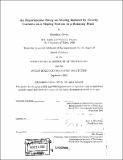An experimental study on mixing induced by gravity currents on a sloping bottom in a rotating fluid
Author(s)
Ohiwa, Mitchihiro, 1977-
DownloadFull printable version (4.542Mb)
Other Contributors
Woods Hole Oceanographic Institution.
Advisor
John A. Whitehead.
Terms of use
Metadata
Show full item recordAbstract
Mixing induced by gravity currents on a sloping bottom was studied through laboratory experiments in a rotating fluid. The dense fluid on the sloping bottom formed a gravity current that could be in regimes where the flow was laminar or had waves. The mixing on a sloping bottom for gravity currents in the laminar and wave regimes was studied both qualitatively and quantitatively. The laboratory experiments were conducted on rotating tables in a tank with homogeneous ambient fluid. The slope angle, rotation rate, reduced gravity, and flow rate of the dense source water were changed for the experiments. The mixing was quantized by measuring the density of the ambient fluid, dense source water, and the bottom water collected at the end of the bottom slope and calculating the ratio of the source water in the bottom water. Comparing the mixing in the laminar regime and the wave regime by changing the slope angle and rotation rate showed that the waves in the gravity current increased the mixing due to the waves. Analysis of the ratio of source water based on the internal Froude number, the Ekman number, and the timescale of the experiments showed that diffusion was not the main mechanism for mixing. The Ekman layer solution was validated by the observation of a streak left by a grain of dye in the dense water layer. The values for the entrainment parameter for the laboratory experiments bracketed those calculated for the Denmark Strait overflow and the Mediterranean outflow, and the values based on observations in the ocean and those from the laboratory were similar for a nondimensional parameter defined using variables used in the laboratory experiments. This shows that the results from the experiments could be used to discuss the mixing in the ocean due to gravity currents along a slope in the ocean and that the waves observed in the laboratory might also be observed in the ocean.
Description
Thesis (S.M.)--Joint Program in Physical Oceanography (Massachusetts Institute of Technology, Dept. of Earth, Atmospheric, and Planetary Sciences and the Woods Hole Oceanographic Institution), 2002. Includes bibliographical references (p. 75-77).
Date issued
2002Department
Joint Program in Physical Oceanography; Woods Hole Oceanographic Institution; Massachusetts Institute of Technology. Department of Earth, Atmospheric, and Planetary SciencesPublisher
Massachusetts Institute of Technology
Keywords
Earth, Atmospheric, and Planetary Sciences., Joint Program in Physical Oceanography., Woods Hole Oceanographic Institution.